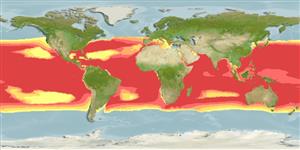Environment: milieu / climate zone / Tiefenbereich / distribution range
Ökologie
seewasser pelagic-oceanic; ozeanodrom (Ref. 51243); tiefenbereich ? - 200 m (Ref. 86942). Subtropical; 42°N - 45°S, 180°W - 180°E
Warm and temperate seas of all oceans. Western Central Pacific: Guam (Ref. 35721). Eastern Pacific: southern California, USA to Peru (Ref. 2850). Western Atlantic: Massachusetts, USA and northern Gulf of Mexico to Brazil (Ref. 7251). Eastern Central Atlantic: Madeira Island (Ref. 74541).
Length at first maturity / Size / Gewicht / Alter
Geschlechtsreife: Lm 13.9, range 11 - 16.8 cm
Max length : 40.0 cm SL Männchen/unbestimmt; (Ref. 5288)
Oceanic species with a strong preference for marlins and sailfish as hosts, but may occasionally cling to other large fishes. Attaches to the body or gill chamber of the host (Ref. 10791). Oviparous. Distinct pairing during breeding (Ref. 57896).
Oviparous. From collection study observations, a mature pair is often found attached to a single host, most often a billfish, indicative of distinct pairing during breeding (Ref. 57896).
Paxton, J.R., D.F. Hoese, G.R. Allen and J.E. Hanley, 1989. Pisces. Petromyzontidae to Carangidae. Zoological Catalogue of Australia, Vol. 7. Australian Government Publishing Service, Canberra, 665 p. (Ref. 7300)
IUCN Rote Liste Status (Ref. 130435: Version 2025-1)
Bedrohung für Menschen
Harmless
Nutzung durch Menschen
Fischereien: nicht kommerziell
Tools
Zusatzinformationen
Download XML
Internet Quellen
Estimates based on models
Preferred temperature (Ref.
123201): 17.3 - 28.2, mean 25.9 °C (based on 1457 cells).
Phylogenetic diversity index (Ref.
82804): PD
50 = 0.5352 [Uniqueness, from 0.5 = low to 2.0 = high].
Bayesian length-weight: a=0.00257 (0.00110 - 0.00600), b=3.17 (2.96 - 3.38), in cm total length, based on LWR estimates for this (Sub)family-body shape (Ref.
93245).
Trophic level (Ref.
69278): 3.5 ±0.50 se; based on food items.
Widerstandsfähigkeit (Ref.
120179): mittel, Verdopplung der Population dauert 1,4 - 4,4 Jahre. (Fec = 8,100).
Fishing Vulnerability (Ref.
59153): Moderate vulnerability (39 of 100).
🛈
